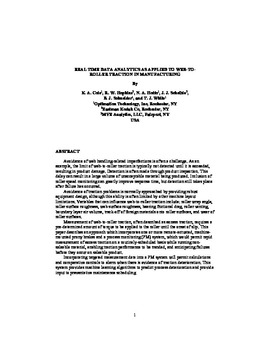| dc.contributor.author | Cole, Kevin A. | |
| dc.contributor.author | Hopkins, R. W. | |
| dc.contributor.author | Hotto, N. A. | |
| dc.contributor.author | Scheible, J. J. | |
| dc.contributor.author | Schneider, Brooks J. | |
| dc.contributor.author | White, Thomas J. | |
| dc.contributor.other | International Conference on Web Handling (2019) | |
| dc.date.accessioned | 2019-06-04T16:16:37Z | |
| dc.date.available | 2019-06-04T16:16:37Z | |
| dc.date.issued | 2019-06 | |
| dc.identifier | oksd_icwh_2019_SchneiderCole | |
| dc.identifier.citation | Cole, K. A., Hopkins, R. W., Hotto, N. A., Scheible, J. J., Schneider, B. J., & White, T. J. (2019, June). Real time data analytics as applied to web-to-roller traction in manufacturing. Paper presented at the Fifteenth International Conference on Web Handling (IWEB), Stillwater, OK. | |
| dc.identifier.uri | https://hdl.handle.net/11244/320265 | |
| dc.description.abstract | Avoidance of web handling-related imperfections is often a challenge. As an example, the limit of web-to-roller traction is typically not detected until it is exceeded, resulting in product damage. Detection is often made through product inspection. This delay can result in a large volume of unacceptable material being produced. Inclusion of roller speed monitoring can greatly improve response time, but detection still takes place after failure has occurred. | |
| dc.description.abstract | Avoidance of traction problems is normally approached by providing robust equipment design, although this ability is often limited by other machine layout limitations. Variables that can influence web-to-roller traction include: roller wrap angle, roller surface roughness, web surface roughness, bearing frictional drag, roller venting, boundary layer air volume, track-off of foreign materials onto roller surfaces, and wear of roller surfaces. | |
| dc.description.abstract | Measurement of web-to-roller traction, often described as excess traction, requires a pre-determined amount of torque to be applied to the roller until the onset of slip. This paper describes an approach which incorporates one or more remote-actuated, machine-mounted prony brakes and a process monitoring (PM) system, which would permit rapid measurement of excess traction on a routinely-scheduled basis while running non-saleable material, enabling traction performance to be trended, and anticipating failures before they occur on saleable product. | |
| dc.description.abstract | Incorporating targeted measurement data into a PM system will permit calculations and comparative controls to alarm when there is evidence of traction deterioration. This system provides machine learning algorithms to predict process deterioration and provide input to preventative maintenance scheduling. | |
| dc.format | application/pdf | |
| dc.language | en_US | |
| dc.publisher | Oklahoma State University | |
| dc.rights | In the Oklahoma State University Library's institutional repository this paper is made available through the open access principles and the terms of agreement/consent between the author(s) and the publisher. The permission policy on the use, reproduction or distribution of the article falls under fair use for educational, scholarship, and research purposes. Contact Digital Resources and Discovery Services at lib-dls@okstate.edu or 405-744-9161 for further information. | |
| dc.title | Real time data analytics as applied to web-to-roller traction in manufacturing | |
| osu.filename | oksd_icwh_2019_SchneiderCole.pdf | |
| dc.type.genre | Conference proceedings | |
| dc.type.material | Text | |
